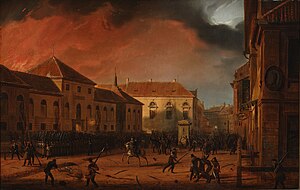November Uprising
| November Uprising | |||||||
|---|---|---|---|---|---|---|---|
| Part of Polish–Russian Wars | |||||||
 Taking of the Warsaw Arsenal. Painting by Marcin Zaleski. |
|||||||
|
|||||||
| Belligerents | |||||||
| Commanders and leaders | |||||||
| Strength | |||||||
| 150,000 | 180,000–200,000 | ||||||
| Casualties and losses | |||||||
| 40,000 killed and wounded | about 22,000–23,000 killed Total killed and wounded at least 60,000 32,000 captured 5,230–12,000 died of disease |
||||||
The November Uprising (1830–31), Polish–Russian War 1830–31, also known as the Cadet Revolution, was an armed rebellion in the heartland of partitioned Poland against the Russian Empire. The uprising began on 29 November 1830 in Warsaw when the young Polish officers from the local Army of the Congress Poland's military academy revolted, led by lieutenant Piotr Wysocki. They were soon joined by large segments of societies of Lithuania, Belarus, and the Right-bank Ukraine. Despite local successes, the uprising was eventually crushed by a numerically superior Imperial Russian Army under Ivan Paskevich.Czar Nicholas I decreed that henceforth Poland was an integral part of Russia, with Warsaw little more than a military garrison, its university closed.
...
Wikipedia
